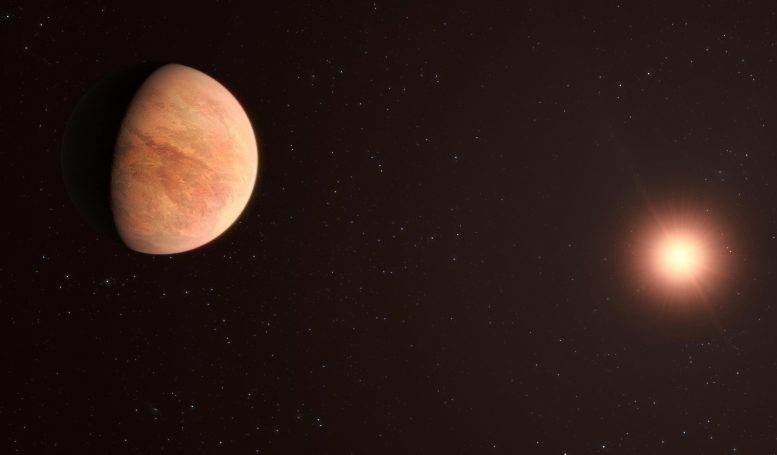
This artist’s impression shows L 98-59b, one of the planets in the L 98-59 system 35 light-years away. The system contains four confirmed rocky planets with a potential fifth, the furthest from the star, being unconfirmed.
In 2021, astronomers used data from the Echelle SPectrograph for Rocky Exoplanets and Stable Spectroscopic Observations (ESPRESSO) instrument on ESO’s VLT to measure the mass of L 98-59b, finding it to be half that of Venus. This makes it the lightest planet measured to date using the radial velocity technique.
Credit: ESO/M. Kornmesser
A team of astronomers has used the European Southern Observatory’s Very Large Telescope (ESO’s VLT) in Chile to shed new light on planets around a nearby star, L 98-59, that resemble those in the inner Solar System. Amongst the findings are a planet with half the mass of Venus — the lightest exoplanet ever to be measured using the radial velocity technique — an ocean world, and a possible planet in the habitable zone.
“The planet in the habitable zone may have an atmosphere that could protect and support life,” says María Rosa Zapatero Osorio, an astronomer at the Center for Astrobiology in Madrid, Spain, and one of the authors of the study published today (August 5, 2021) in Astronomy & Astrophysics.
The results are an important step in the quest to find life on Earth-sized planets outside the Solar System. The detection of biosignatures on an exoplanet depends on the ability to study its atmosphere, but current telescopes are not large enough to achieve the resolution needed to do this for small, rocky planets. The newly studied planetary system, called L 98-59 after its star, is an attractive target for future observations of exoplanet atmospheres. It orbits a star only 35 light-years away and has now been found to host rocky planets, like Earth or Venus, which are close enough to the star to be warm.
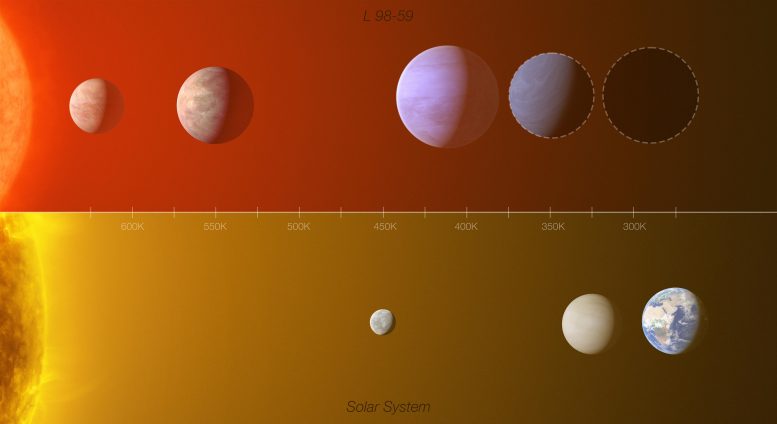
This infographic shows a comparison between the L 98-59 exoplanet system (top) with part of the inner Solar System (Mercury, Venus, and Earth), highlighting the similarities between the two.
L 98-59 contains four confirmed rocky planets (marked in color in the top panel), orbiting a red-dwarf star 35 light-years away. The planet closest to the star is around half the mass of Venus, making it the lightest exoplanet ever detected using the radial velocity technique. Up to 30% of the third planet’s mass could be water, making it an ocean world. The existence of the fourth planet has been confirmed, but scientists don’t yet know its mass and radius (its possible size is indicated by a dotted line). The team also found hints of a potential fifth planet, the furthest from the star, though the team knows little about it. If confirmed, it would sit in the system’s habitable zone where liquid water could exist on its surface.
The distances from the stars and between the planets in the infographic are not up to scale. The diagram has been scaled to make the habitable zone in both the Solar System and in L 98-59 coincide. As indicated by the infographic, which includes a temperature scale (in Kelvin [K]), the Earth and the fifth (unconfirmed) planet in L 98-59 receive similar amounts of light and heat from their respective stars. Assuming their atmospheres are similar, this fifth planet would have a similar average surface temperature to Earth and would support liquid water at its surface.
Credit: ESO/L. Calçada/M. Kornmesser (Acknowledgment: O. Demangeon)
Furthermore, the team found “hidden” exoplanets that had not previously been spotted in this planetary system. They discovered a fourth planet and suspect there is a fifth, in a zone at the right distance from the star for liquid water to exist on its surface. “We have hints of the presence of a terrestrial planet in the habitable zone of this system,” explains Olivier Demangeon, a researcher at the Instituto de Astrofísica e Ciências do Espaço, University of Porto in Portugal and lead author of the new study.
The study represents a technical breakthrough, as astronomers were able to determine, using the radial velocity method, that the innermost planet in the system has just half the mass of Venus. This makes it the lightest exoplanet ever measured using this technique, which calculates the wobble of the star caused by the tiny gravitational tug of its orbiting planets.
The team used the Echelle SPectrograph for Rocky Exoplanets and Stable Spectroscopic Observations (ESPRESSO) instrument on ESO’s VLT to study L 98-59. “Without the precision and stability provided by ESPRESSO this measurement would have not been possible,” says Zapatero Osorio. “This is a step forward in our ability to measure the masses of the smallest planets beyond the Solar System.”
The astronomers first spotted three of L 98-59’s planets in 2019, using NASA’s Transiting Exoplanet Survey Satellite (TESS). This satellite relies on a technique called the transit method — where the dip in the light coming from the star caused by a planet passing in front of it is used to infer the properties of the planet — to find the planets and measure their sizes. However, it was only with the addition of radial velocity measurements made with ESPRESSO and its predecessor, the High Accuracy Radial velocity Planet Searcher (HARPS) at the ESO La Silla 3.6-meter telescope, that Demangeon and his team were able to find extra planets and measure the masses and radii of the first three. “If we want to know what a planet is made of, the minimum that we need is its mass and its radius,” Demangeon explains.
The team hopes to continue to study the system with the forthcoming NASA/ESA/CSA James Webb Space Telescope (JWST), while ESO’s Extremely Large Telescope (ELT), under construction in the Chilean Atacama Desert and set to start observations in 2027, will also be ideal for studying these planets. “The HIRES instrument on the ELT may have the power to study the atmospheres of some of the planets in the L 98-59 system, thus complementing the JWST from the ground,” says Zapatero Osorio.
“This system announces what is to come,” adds Demangeon. “We, as a society, have been chasing terrestrial planets since the birth of astronomy and now we are finally getting closer and closer to the detection of a terrestrial planet in the habitable zone of its star, of which we could study the atmosphere.”
More information
This research was presented in a paper entitled to appear in Astronomy & Astrophysics.
Reference: “A warm terrestrial planet with half the mass of Venus transiting a nearby star” by O. D. S. Demangeon, M. R. Zapatero Osorio, Y. Alibert, S. C. C. Barros, V. Adibekyan, H. M. Tabernero, A. Antoniadis-Karnavas, J. D. Camacho, et al., Accepted, Astronomy & Astrophysics.
DOI: 10.1051/0004-6361/202140728
The team is composed of Olivier D. S. Demangeon (Instituto de Astrofísica e Ciências do Espaço, Universidade do Porto, Portugal [IA/UPorto], Centro de Astrofísica da Universidade do Porto, Portugal [CAUP] and Departamento de Física e Astronomia, Faculdade de Ciências, Universidade do Porto, Portugal [FCUP]), M. R. Zapatero Osorio (Centro de Astrobiología, Madrid, Spain [CSIC-INTA]), Y. Alibert (Physics Institute, University of Bern, Switzerland [Bern]), S. C. C. Barros (IA/UPorto, CAUP and FCUP), V. Adibekyan (IA/UPorto, CAUP and FCUP), H. M. Tabernero (IA/UPorto and CAUP), A. Antoniadis-Karnavas (IA/UPorto & FCUP), J. D. Camacho (IA/UPorto & FCUP), A. Suárez Mascareño (Instituto de Astrofísica de Canarias, Tenerife, Spain [IAC] and Departamento de Astrofísica, Universidad de La Laguna, Tenerife, Spain [ULL]), M. Oshagh (IAC/ULL), G. Micela (INAF – Osservatorio Astronomico di Palermo, Palermo, Italy), S. G. Sousa (IA/UPortol & CAUP), C. Lovis (Observatoire de Genève, Université de Genève, Geneva, Switzerland [UNIGE]), F. A. Pepe (UNIGE), R. Rebolo (IAC/ULL & Consejo Superior de Investigaciones Científicas, Spain), S. Cristiani (INAF – Osservatorio Astronomico di Trieste, Italy [INAF Trieste]), N. C. Santos (IA/UPorto, CAUP and FCUP), R. Allart (Department of Physics and Institute for Research on Exoplanets, Université de Montréal, Canada and UNIGE), C. Allende Prieto (IAC/ULL), D. Bossini (IA/UPorto), F. Bouchy (UNIGE), A. Cabral (Instituto de Astrofísica e Ciências do Espaço, Faculdade de Ciências da Universidade de Lisboa, Portugal [IA/FCUL] and Departamento de Física da Faculdade de Ciências da Universidade de Lisboa, Portugal), M. Damasso (INAF – Osservatorio Astrofisico di Torino, Italy [INAF Torino]), P. Di Marcantonio (INAF Trieste), V. D’Odorico (INAF Trieste & Institute for Fundamental Physics of the Universe, Trieste, Italy [IFPU]), D. Ehrenreich (UNIGE), J. Faria (IA/UPorto, CAUP and FCUP), P. Figueira (European Southern Observatory, Santiago de Chile, Chile [ESO-Chile] and IA/UPorto), R. Génova Santos (IAC/ULL), J. Haldemann (Bern), J. I. González Hernández (IAC/ULL), B. Lavie (UNIGE), J. Lillo-Box (CSIC-INTA), G. Lo Curto (European Southern Observatory, Garching bei München, Germany [ESO]), C. J. A. P. Martins (IA/UPorto and CAUP), D. Mégevand (UNIGE), A. Mehner (ESO-Chile), P. Molaro (INAF Trieste and IFPU), N. J. Nunes (IA/FCUL), E. Pallé (IAC/ULL), L. Pasquini (ESO), E. Poretti (Fundación G. Galilei – INAF Telescopio Nazionale Galileo, La Palma, Spain and INAF – Osservatorio Astronomico di Brera, Italy), A. Sozzetti (INAF Torino), and S. Udry (UNIGE).
ESO is the foremost intergovernmental astronomy organization in Europe and the world’s most productive ground-based astronomical observatory by far. It has 16 Member States: Austria, Belgium, the Czech Republic, Denmark, France, Finland, Germany, Ireland, Italy, the Netherlands, Poland, Portugal, Spain, Sweden, Switzerland, and the United Kingdom, along with the host state of Chile and with Australia as a Strategic Partner. ESO carries out an ambitious program focused on the design, construction, and operation of powerful ground-based observing facilities enabling astronomers to make important scientific discoveries. ESO also plays a leading role in promoting and organizing cooperation in astronomical research. ESO operates three unique world-class observing sites in Chile: La Silla, Paranal, and Chajnantor. At Paranal, ESO operates the Very Large Telescope and its world-leading Very Large Telescope Interferometer as well as two survey telescopes, VISTA working in the infrared and the visible-light VLT Survey Telescope. Also at Paranal ESO will host and operate the Cherenkov Telescope Array South, the world’s largest and most sensitive gamma-ray observatory. ESO is also a major partner in two facilities on Chajnantor, APEX, and ALMA, the largest astronomical project in existence. And on Cerro Armazones, close to Paranal, ESO is building the 39-meter Extremely Large Telescope, the ELT, which will become “the world’s biggest eye on the sky.”

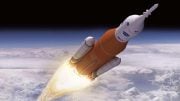
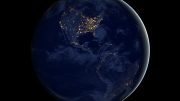



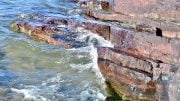
This is a great mile stone for ESO’s VLT. But, are we searching for a place where only we can live or a beings like us can live? We are not searching for a place where an organism(any form) that may exist in the universe can live. We restrict ourselves to a particular region by assuming that any organism in the universe could live only in the place where we can live. But this is extremely wrong. Any organisms that evolve/orginate from a place in the entire universe can grow further/develop/evolve/live in that place by adapting to the environment/nature of that place. An organism evolving from a place will have the ability to live in that place and may sustain. So life can exist in any region in the universe even in the hot stars or planets, in the cosmic dust, or clouds etc…. So we should change our openion about the existence of life in the universe and we should search for that not from the prespective of humans in the pale blue dot but from the perspective of the universe.